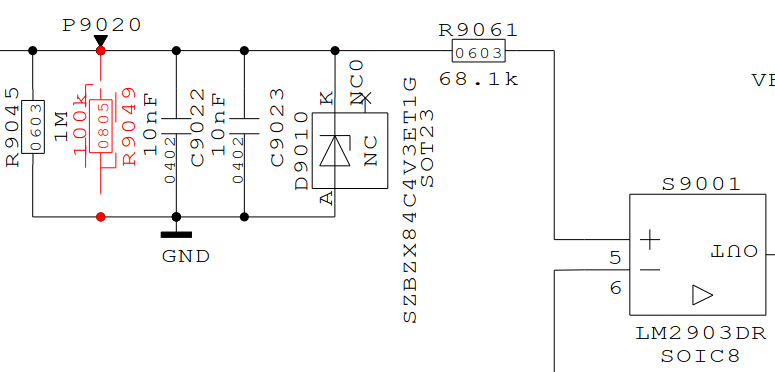- Ask a related questionWhat is a related question?A related question is a question created from another question. When the related question is created, it will be automatically linked to the original question.
This thread has been locked.
If you have a related question, please click the "Ask a related question" button in the top right corner. The newly created question will be automatically linked to this question.
Dear team,
According to bias current/-50nA and offset current/25nA, input bias current Ib+=-37.5nA, Ib-=-72.5nA. If there is no input voltage, what is the max deviation voltage at P9020 test point?


Thanks & Best Regards,
Sherry
Hi Sherry,
the input bias current is always flowing out of the LM2903 because the input stage consists of PNP transistors. And it will be less than 50nA. So the maximum voltage drop across the parallel circuit of R9049 and R9045 will be
90909R x 50nA = 4.5mV
And there's also a leakage current flowing through the zener diode D9010 which will eventually lower the 4.5mV voltage drop a bit.
The input offset current is no additional current but is the imbalance of the both input bias currents. As example, the input bias currents can be -3.5nA and -3.0nA or -3.5nA and -4.0nA, typically.
Keep in mind, that the leakage current through the zener current may heavily increase at voltages even below the 4.3V threshold voltage. It is typical for low voltage zener diodes that their U / I knee is not sharp.
Kai
Hi kai,
Thanks for your reply!
I am a little confused about the definition of input bias current. In my understanding input bias current =1/2((Iin+)+(Iin-)), and input offset current =(Iin+)-(Iin-). Therefore according to bias current/-50nA and offset current/25nA, (In+)=-37.5nA, (In-)=-72.5nA. You mean (In+)=-50nA, (In-)=-50nA according to our datasheet spec?
Thanks & Best Regards,
Sherry
Kai, thank you for the great explanation.
Hi Sherry,
Yes, the definition of input bias current is applied to each inputs individually, not the average. In this case, the maximum could be In+=-50nA and In-=-50nA but potentially different by a maximum of 25 nA (the input offset current).